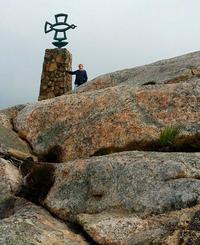Photo. The monument titled Pax on the top of the hill nearby Lindesnes Lighthouse. The "Pax Monument" is raised in memory of the liner M/S Palatia which was torpedoed during the Second World War. Steamship Palatia that was sank by a British plane in October 1942, with about 970 Russian Prisoners of War (POWs) on board.
MS Palatia - a memorial monument for the second greatest ship sinking disaster in Norwegian history. On 21st October 1942 the German liner MS Palatia was sailing off Lindesnes, Norway. The big paradox was that the ship was sunk by a allied during the war. What did really happened? A Royal New Zealand Air Force torpedo bomber, while carrying a load of prisoners of war intended for slave labour in German-occupied Norway. In total, 986 people have later been reported killed in the incident; 915 prisoners, in addition to German soldiers and crew members.
See more photos on Travel Explorations` Facebook page. A memorial was raised at Lindesnes and unveiled by King Harald V of Norway on 21 September 1997.
MS Palatia was a German liner, built in 1928. After serving for several years on the Hamburg America Line's route to the Caribbean, she was sold to the Soviet Union in 1940. Following the outbreak of war between Nazi Germany and the Soviet Union in June 1941, she was captured by the Germans and pressed into Kriegsmarine service.
In 1940, during a period of improved relations between Nazi Germany and the Soviet Union, Palatia was sold to the Soviet Union and renamed Khasan. After the German invasion of Russia, she was confiscated by the Kriegsmarine on 22 June 1941 while in the German port city of Stettin. She had her original name Palatia restored.
On her last mission she was used as a prisoner of war transport from Stettin to Ålesund, via Kristiansand, in order to bring slave labourers to work for the Nazi occupants. She carried 999 prisoners and a crew of 34, as well as a Norwegian pilot.
At a ceremony commemorating the 50th anniversary of the end of the Second World War in Europe, the Lindesnes led on May 6, 1995, a memorial service to commemorate the Palatia disaster accompanied by an exhibition of finds. Through the salvage vessel Tyr the Norwegian Navy in 1997, the wreck was precisely located and explained to the memorial and forbidden to dive. King Harald V of Norway unveiled on 21 September 1997 Lindesnes a monument in honor of the victims. In this celebration a choir sang with 986 singers: a singer for every life that was lost on the Palatia.
About 100,000 Russian, Ukrainian and Belorussian prisoners-of-war were kept by Nazi on the Norwegian soil during the war. Some 14,000 died here. The Soviet Army liberated a part of Northern Norway (Finnmark province) by October 24, 1944, having lost some 20,000 in the operation.
The number of perished has been listed as 986 people, including 915 prisoners from the Soviet Union or Eastern Europe. The incident was not reported in the censored press at the time. For weeks after the sinking of Palatia large numbers of corpses floated ashore on the beaches as far as the Lista area (Farsund, Vest Agder county in southwestern Norway). The bodies were collected and removed by the Germans.
The monument was standing of the top of the hill. The "Pax Monument" is erected in memory of the liner M/S Palatia which was torpedoed during the Second World War. The wreck of Palatia rests at a depth of seventy to over a hundred meters, and is fairly destroyed after the attack in 1942. Palatia resting in open waters outside Lindesnes and is classified as a war grave. By Lindesnes lighthouse stands a monument atop a knoll commemorating the tragedy, Pax Monument. It depicts a bird made of tile, as many Russian prisoners of war carved and gladly gave away in exchange for food and cigarettes.
The memorial monument, titled Pax, was designed by sculptor Arne Vinje Gunnerud. Pax consists of a Common Buzzard in bronze with unfolded wings, on a platform of natural rock. The monument was built on the initiative of Sørlandet krigsminneforening (English: Southern Norway war memorial society) and Lindesnes municipality.
Stein Morten Lund, 21st July 2015
Additional information
See photo of the liner and read more about the ship on Wikipedia.












